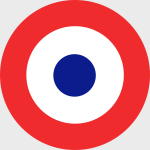DeAgostini DAWF37 Vichy French Air Force Dewoitine D.520 Fighter - Pierre Le Gloan, GC III/6, Syria, 1941 [With Collector Magazine] (1:72 Scale)
"A lost battle is a battle one thinks one has lost."
- Marshal Ferdinand Foch
 The Dewoitine D.520 was perhaps the best fighter available to the Armee de l'Air during the German invasion of France in May 1940. It was yet another example of a combat aircraft which flew on both sides during World War II.
The Dewoitine D.520 was perhaps the best fighter available to the Armee de l'Air during the German invasion of France in May 1940. It was yet another example of a combat aircraft which flew on both sides during World War II.
The D.520 was a single-seat, single-engine, low-wing fighter powered by a liquid-cooled Hispano-Suiza 12Y Vee-type engine. It was designed in November 1936 by a team led by Emile Dewoitine, who was at that time the director of a private design office. It was designed in response to a specification issued in 1937 for a single seat fighter and built around the 900hp Hispano-Suiza 12Y-21 liquid-cooled engine, which was to have a maximum speed of 323 mph (520 km/hr). The designation D.520 was assigned, the 520 standing for the maximum speed in kilometers per hour the aircraft could attain. Provisions were made for the future installation of an appreciably more powerful 1200 hp engine then under development by Hispano-Suiza.
Pictured here is a 1:72 scale replica of a French Dewoitine D.520 fighter that was piloted by Pierre Le Gloan, who was attached to GC III/6, then deployed to Syria during 1941.
Now in stock!
Dimensions:
Wingspan: 5-1/4-inches
Length: 5-inches
Release Date: February 2021
Historical Account: "Vichy Water" - On June 17th, 1940, five days before the signing of the Franco-German Armistice, the first "exodus" of 10 airmen took flight from Bordeaux-Marignac to England. Others rallied to General Charles de Gaulle from France and French North Africa during the period of June 1940 to November 1942. From a strength of 500 in July 1940, the ranks of the Forces Aeriennes Francaises Libres (FAFL) had grown to 900 by 1941, including 200 flyers. A total of 276 of these flyers were stationed in England, and 604 were stationed on exterior theaters of operation. General de Gaulle named then-Colonel Martin Valin as commander-in-chief of the FAFL in the summer of 1940, though he was at the French military mission in Rio de Janeiro, Brazil, at the time of his appointment. He was required to complete his assignment there by February 1941, yet it took him some 45 days to get to London to see de Gaulle. It was not until he took over from the caretaker commander, Admiral Emile Muselier, that Valin formally assumed office on July 9th, 1941.
All FAFL aircraft were to be identified differently from those of the Vichy French air force, which continued to sport the tricolor roundel. The Cross of Lorraine, a cross with two parallel horizontal arms, with the lower arm slightly longer than the upper one, was the symbol of Free France chosen by Charles de Gaulle. It was chosen in order to distinguish their allegiance from those of their countrymen now having to fight, however reluctantly, for the benefit of a country friendly to the Axis powers. The cross could be seen in the same places on FAFL aircraft where the roundels used to be on all French military aircraft, that is, on the fuselage and on the lower and upper surfaces of the wings.







![USAF McDonnell RF-4C Phantom II Reconnaissance Aircraft - 106th Tactical Reconnaissance Squadron, 117th Tactical Reconnaissance Wing, Alabama Air National Guard, Operation Desert Storm, 1991 [Low-Vis Scheme] (1:72 Scale)](http://cdn4.volusion.store/qh9e9-jdqv9/v/vspfiles/photos/HA1951-1.jpg?v-cache=1740197136)
![RCAF Boeing CF-18A Hornet Strike Fighter - 425 Tactical Fighter Squadron "Alouettes", Canadian Forces Air Command, "Operation Mobile", Libya, 2011 [Low-Vis Scheme] (1:72 Scale)](http://cdn4.volusion.store/qh9e9-jdqv9/v/vspfiles/photos/HA3502-1.jpg?v-cache=1740197136)
